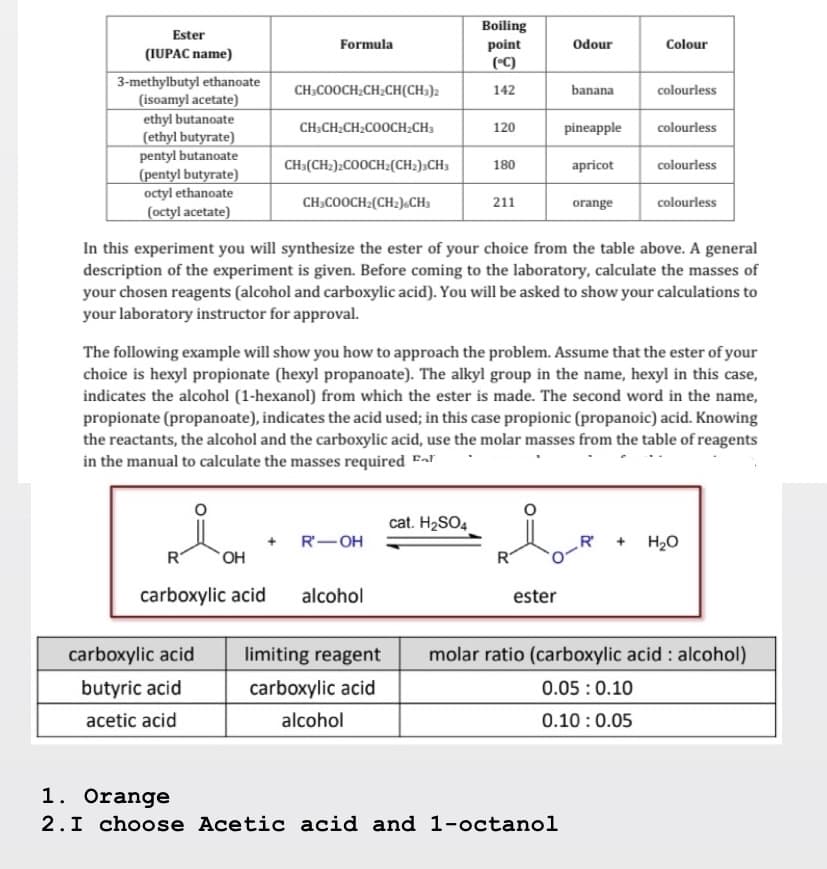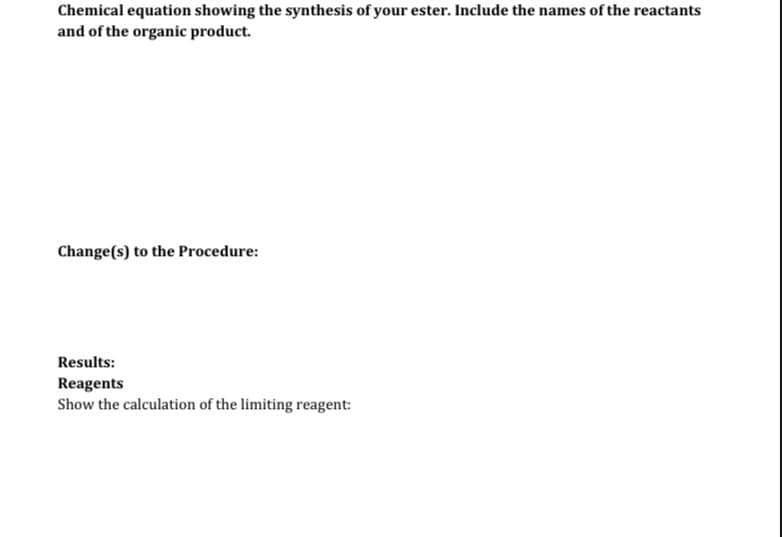Introductory Chemistry: A Foundation
9th Edition
ISBN:9781337399425
Author:Steven S. Zumdahl, Donald J. DeCoste
Publisher:Steven S. Zumdahl, Donald J. DeCoste
Chapter20: Organic Chemistry
Section: Chapter Questions
Problem 146CP
Related questions
Question
The odour was orang.
Made of acetic acid and 1-octanol.
Mass of 1-octanol= 6.51 g
Mass of acetic acids = 6.00 g
Please answer in detail

Transcribed Image Text:Ester
(IUPAC name)
3-methylbutyl ethanoate
(isoamyl acetate)
ethyl butanoate
(ethyl butyrate)
pentyl butanoate
(pentyl butyrate)
octyl ethanoate
(octyl acetate)
R
Formula
OH
carboxylic acid
CH3COOCH₂CH₂CH(CH3)2
carboxylic acid
butyric acid
acetic acid
CH3CH₂CH₂COOCH₂CH3
CH3(CH₂)2COOCH₂(CH₂)3CH3
CH3COOCH₂(CH₂)<CH₂
+ R-OH
alcohol
Boiling
point
(°C)
142
limiting reagent
carboxylic acid
alcohol
120
cat. H₂SO4
180
211
In this experiment you will synthesize the ester of your choice from the table above. A general
description of the experiment is given. Before coming to the laboratory, calculate the masses of
your chosen reagents (alcohol and carboxylic acid). You will be asked to show your calculations to
your laboratory instructor for approval.
The following example will show you how to approach the problem. Assume that the ester of your
choice is hexyl propionate (hexyl propanoate). The alkyl group in the name, hexyl in this case,
indicates the alcohol (1-hexanol) from which the ester is made. The second word in the name,
propionate (propanoate), indicates the acid used; in this case propionic (propanoic) acid. Knowing
the reactants, the alcohol and the carboxylic acid, use the molar masses from the table of reagents
in the manual to calculate the masses required Far
R
Odour
ester
banana
pineapple
apricot
orange
1. Orange
2. I choose Acetic acid and 1-octanol
Colour
colourless
colourless
0.100.05
colourless
colourless
+ H₂O
molar ratio (carboxylic acid: alcohol)
0.05 0.10

Transcribed Image Text:Chemical equation showing the synthesis of your ester. Include the names of the reactants
and of the organic product.
Change(s) to the Procedure:
Results:
Reagents
Show the calculation of the limiting reagent:
Expert Solution
This question has been solved!
Explore an expertly crafted, step-by-step solution for a thorough understanding of key concepts.
This is a popular solution!
Trending now
This is a popular solution!
Step by step
Solved in 2 steps with 2 images

Knowledge Booster
Learn more about
Need a deep-dive on the concept behind this application? Look no further. Learn more about this topic, chemistry and related others by exploring similar questions and additional content below.Recommended textbooks for you

Introductory Chemistry: A Foundation
Chemistry
ISBN:
9781337399425
Author:
Steven S. Zumdahl, Donald J. DeCoste
Publisher:
Cengage Learning


Chemistry
Chemistry
ISBN:
9781305957404
Author:
Steven S. Zumdahl, Susan A. Zumdahl, Donald J. DeCoste
Publisher:
Cengage Learning

Introductory Chemistry: A Foundation
Chemistry
ISBN:
9781337399425
Author:
Steven S. Zumdahl, Donald J. DeCoste
Publisher:
Cengage Learning


Chemistry
Chemistry
ISBN:
9781305957404
Author:
Steven S. Zumdahl, Susan A. Zumdahl, Donald J. DeCoste
Publisher:
Cengage Learning

Chemistry: An Atoms First Approach
Chemistry
ISBN:
9781305079243
Author:
Steven S. Zumdahl, Susan A. Zumdahl
Publisher:
Cengage Learning

Introduction to General, Organic and Biochemistry
Chemistry
ISBN:
9781285869759
Author:
Frederick A. Bettelheim, William H. Brown, Mary K. Campbell, Shawn O. Farrell, Omar Torres
Publisher:
Cengage Learning

Chemistry for Today: General, Organic, and Bioche…
Chemistry
ISBN:
9781305960060
Author:
Spencer L. Seager, Michael R. Slabaugh, Maren S. Hansen
Publisher:
Cengage Learning